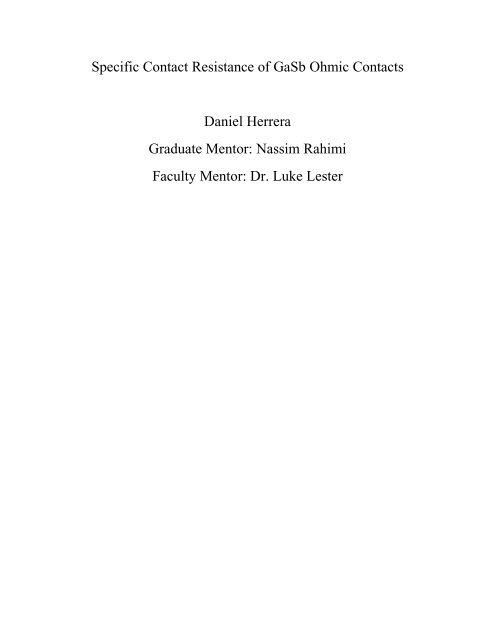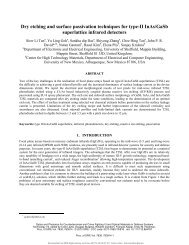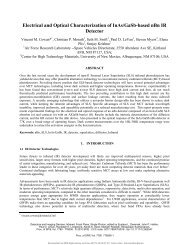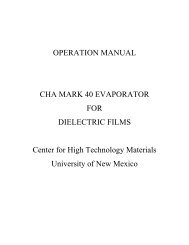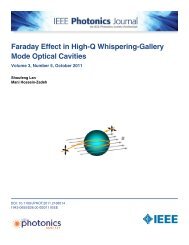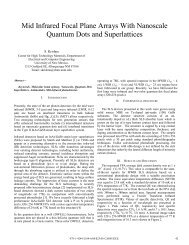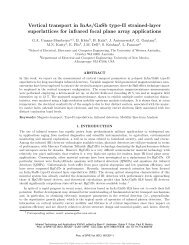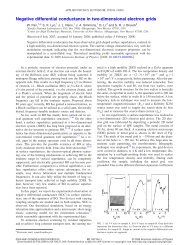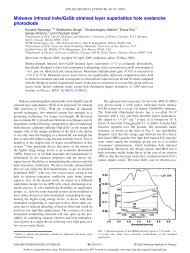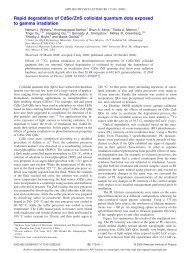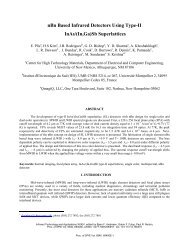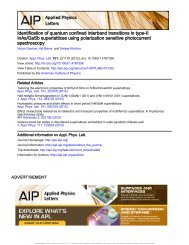Specific Contact Resistance of GaSb Ohmic Contacts Daniel ...
Specific Contact Resistance of GaSb Ohmic Contacts Daniel ...
Specific Contact Resistance of GaSb Ohmic Contacts Daniel ...
Create successful ePaper yourself
Turn your PDF publications into a flip-book with our unique Google optimized e-Paper software.
<strong>Specific</strong> <strong>Contact</strong> <strong>Resistance</strong> <strong>of</strong> <strong>GaSb</strong> <strong>Ohmic</strong> <strong>Contact</strong>s<br />
<strong>Daniel</strong> Herrera<br />
Graduate Mentor: Nassim Rahimi<br />
Faculty Mentor: Dr. Luke Lester
Activities<br />
Introduction<br />
My name is <strong>Daniel</strong> Herrera, and I’m a junior studying electrical engineering. After being<br />
accepted into the CHTM REU program, I was placed into Dr. Luke Lester’s research group,<br />
which focuses on the research on solar cells and other optoelectronic devices. I was to follow<br />
instructions given by my graduate mentor, Nassim Rahimi and otherwise assist the group in any<br />
other way. My work was focused on the research <strong>of</strong> creating high-efficiency gallium antimonide<br />
(<strong>GaSb</strong>) ohmic contact structures. The vast majority <strong>of</strong> my work was done in the cleanroom at<br />
CHTM, where I processed and tested the ohmic contacts.<br />
Background<br />
I am currently a junior studying electrical engineering, therefore my background prepared<br />
me fairly well for this program. During the fall semester, I was enrolled in ECE 371, which is a<br />
materials and devices course for electrical engineers. While enrolled in that class, I learned about<br />
semiconductor physics while simultaneously doing research at CHTM. I feel that I would have<br />
been better prepared had I taken the course before participating in this program, but the program<br />
also accelerated my learning and understanding <strong>of</strong> the material. As a result <strong>of</strong> my work at<br />
CHTM, I have decided to build upon what I’ve learned by focusing in the optoelectronics track<br />
in the ECE program at UNM.<br />
Research Objective<br />
The objective <strong>of</strong> my research is to test the specific contact resistance <strong>of</strong> <strong>GaSb</strong> and<br />
compare the results to that <strong>of</strong> gallium arsenide (GaAs). An ohmic contact is a non-rectifying<br />
junction between a series <strong>of</strong> metals and a semiconductor. <strong>Ohmic</strong> contacts are used when current<br />
needs to be transferred from one semiconductor to another in many electronic devices. The<br />
current-voltage (IV) characteristics <strong>of</strong> an ohmic contact are linear, as opposed to rectifying<br />
metal-semiconductor barriers (Schottky barriers), which don’t conduct any current until a<br />
threshold voltage has been reached.<br />
To create an ohmic contact, a metal structure is joined to a semiconductor that has a<br />
similar, low energy band-gap. The junction <strong>of</strong> these two materials creates an energy barrier that<br />
stops the flow <strong>of</strong> electrons. To minimize the energy barrier, a low band-gap material is usually<br />
placed between the metal and semiconductor. This is usually another type <strong>of</strong> semiconductor with<br />
a higher doping concentration. Below are the band diagrams for n and p doped ohmic contacts.
n-doped <strong>Ohmic</strong> contact<br />
p-doped ohmic contact<br />
As shown above in the figures, there is a small energy barrier between the conduction<br />
bands <strong>of</strong> the metal and semiconductor. The goal <strong>of</strong> ohmic contact research is to minimize that<br />
barrier, so that electrons can quantum mechanically tunnel easily through to the other side. The<br />
main reason my research was done on <strong>GaSb</strong> is because very little research has been done on it,<br />
while plenty <strong>of</strong> research and manufacturing has already been done on gallium arsenide (GaAs).<br />
Many different methods have already proven to be successful for GaAs, while <strong>GaSb</strong> has the<br />
potential to be a better ohmic contact material, since it has a lower energy band-gap.
The main characterizations <strong>of</strong> high quality ohmic contacts are cleanliness, morphology,<br />
thermal stability, and contact resistance. For an ohmic contact to have high quality IV traces, the<br />
surface must be free <strong>of</strong> any dirt or scum that can either impede current transfer or cause a short<br />
circuit. The sample also must be completely smooth and level, so that the current is more easily<br />
isolated into one path. The ohmic contact should not degrade at higher temperatures or react with<br />
oxygen. Finally, lower contact resistances are vital, with the target contact resistance being close<br />
to 5x10 -6 Ω·cm 2 or lower.<br />
Methodology<br />
Being that I was to fabricate ohmic contacts on semiconductor materials, 100 percent <strong>of</strong><br />
my work was done within the cleanroom at CHTM. Before any fabrication was to be done, I was<br />
to first be trained to gain access into the cleanroom. This included watching several safety<br />
videos, followed by a comprehensive test on the material. After gaining access to the cleanroom,<br />
I needed to be trained and tested on the equipment that I would be using.<br />
The major parts <strong>of</strong> the fabrication to be done were photolithography, inductively couple<br />
plasma etching (ICP), and metallization. Photolithography is the process <strong>of</strong> creating a nano-scale<br />
pattern on a semiconductor wafer by using photoresist, which has special characteristics when<br />
exposed to ultra-violet light. In my research, I used AZ-5214-E_IR photoresist, which becomes<br />
soluble in a developer solution after being exposed to UV light. To utilize the photoresist, I<br />
exposed the samples using specific patterned masks which only cover some parts <strong>of</strong> the sample.<br />
After exposure and development, a photoresist pattern on the sample will match the pattern on<br />
the mask.<br />
The process for photolithography on a GaAs sample is listed below:<br />
1. Soak the substrate for 5 minutes each in acetone, methanol, and isopropyl alcohol<br />
(IPA) before rinsing with deionized (DI) water and blowing dry with nitrogen.<br />
2. Remove the native oxide on the sample by soaking in NH 4 OH for 30 seconds,<br />
then blow dry with nitrogen.<br />
3. Bake the sample for 10 minutes at 150°C<br />
4. Spin hexamethyldisilazane (HMDS) onto the sample at 4000 rpm for 30 seconds<br />
5. Bake the sample for 3 minutes at 150°C after spinning on the HMDS.<br />
6. Spin AZ-5214-E_IR photoresist onto the sample at 4000 rpm for 30 seconds.<br />
7. S<strong>of</strong>t bake the sample at 90°C for 2 minutes.<br />
8. Place sample onto Karl Suss Mask Aligner and adjust height <strong>of</strong> stage until the<br />
sample comes into contact with the mask being used (mesa etching or metal<br />
deposition)<br />
9. Expose the sample to 405nm wavelength ultraviolet light for 2 seconds using the<br />
mask aligner.
10. Bake the sample at 112°C for 1 minute.<br />
11. Expose the sample to 205 nm wavelength light again for 30 seconds, but without<br />
using a mask on the aligner (flood exposure)<br />
12. Develop the sample by soaking in a 1:4 ratio <strong>of</strong> AZ400K developer: DI water<br />
solution for 20 seconds.<br />
13. Remove sample from solution and immediately blow dry with nitrogen gun.<br />
14. After inspecting the pattern definition on the sample, clean sample with the<br />
oxygen reactive ion etcher (RIE) for 1 minute with a pressure <strong>of</strong> 90 mTorr and a<br />
power <strong>of</strong> 50 W.<br />
There were a few necessary adjustments in the above process for <strong>GaSb</strong>. Rather than using<br />
NH 4 OH to remove the native oxide, I used a 1:3 ratio <strong>of</strong> HCl and DI water for 30 seconds. Also,<br />
the sample’s contact with water had to be limited, so instead <strong>of</strong> soaking the sample in each<br />
solvent for 5 minutes, I simply washed it with each solvent and rinsed with DI water before<br />
immediately blow drying the sample.<br />
After photolithography, ICP etching was done on the samples. This process etched into<br />
the substrate only where the photoresist pattern did not exist. Following the etching, I rinsed the<br />
excess photoresist <strong>of</strong>f <strong>of</strong> the sample, which left a pattern <strong>of</strong> mesa-like structures on the surface.<br />
Then, the same photolithography process was done, but using a mask specific for the metal<br />
structures <strong>of</strong> the contacts. The pattern <strong>of</strong> these structures was aligned so that the ohmic contacts<br />
were within the mesa structures. After photolithography, the oxide on top the sample was<br />
removed again before evaporating the metal on the sample. Below is a picture <strong>of</strong> a sample after<br />
mesa photolithography and ICP etching.
To perform metal evaporation, the sample is first placed into a chamber which is pumped<br />
down to about 2 x 10 -6 Torr or lower. Then, a high-intensity electron beam steered by magnetic<br />
coils is projected down onto a metal source. Once the temperature <strong>of</strong> the source rises enough,<br />
metal particles then begin evaporate and rise up and stick onto the sample, which is directly<br />
above the source. The metal sequence most commonly done for the <strong>GaSb</strong> samples was<br />
Ge/Au/Ni/Ti/Au. Below is a photo taken from the microscope <strong>of</strong> the TLM (Transmission Line<br />
Method) pattern on the sample. The distance between two consecutive contacts increases from<br />
10 microns to 70 microns.<br />
After metal deposition, the sample would go through an annealing process, which quickly<br />
rises the temperature <strong>of</strong> the sample, before cooling down. This process alters many<br />
characteristics <strong>of</strong> the sample, including ductility, hardness, and internal stresses. Each sample<br />
was annealed at a different temperature to observe the changes in specific contact resistance, or<br />
not annealed at all.<br />
Finally, to measure the specific contact resistance <strong>of</strong> the ohmic contacts, a 2-probe IV<br />
(current-voltage) curve tracer was used. The two probes were placed on two consecutive ohmic<br />
contacts. Then, the machine applies a voltage across the two probes. The curve tracer measures<br />
the current passing from one probe to the other and plots the current as a function <strong>of</strong> voltage.<br />
This process was repeated several times for each distance between two contacts. The following<br />
figure gives the IV curve for one distance.
-1<br />
-0.910000026<br />
-0.819999993<br />
-0.730000019<br />
-0.639999986<br />
-0.550000012<br />
-0.460000008<br />
-0.370000005<br />
-0.280000001<br />
-0.189999998<br />
-0.100000002<br />
-0.01<br />
0.079999998<br />
0.170000002<br />
0.259999991<br />
0.349999994<br />
0.439999998<br />
0.529999971<br />
0.620000005<br />
0.709999979<br />
0.800000012<br />
0.889999986<br />
0.980000019<br />
0.0015<br />
n-<strong>GaSb</strong> 40 μm<br />
0.001<br />
0.0005<br />
0<br />
Current<br />
-0.0005<br />
-0.001<br />
-0.0015<br />
Voltage<br />
As shown in the figure, the contact displays a linear or ohmic relationship. After<br />
repeating for all distances, the resistance is found by Ohm’s Law and plotted as a function <strong>of</strong><br />
distance. After the resistance is plotted, the transfer length L T and the transfer resistance R T can<br />
be found by solving for the intercepts <strong>of</strong> that line, as shown below.
Using the transfer resistance and transfer length, the specific contact resistance can be<br />
bound by using the following equation,<br />
where Z is the width <strong>of</strong> the channel, R C is the contact resistance, and L T is the transfer length.<br />
The total resistance <strong>of</strong> two ohmic contacts is shown in the following figure. There is a contact<br />
resistance from each ohmic contact, along with a sheet resistance coming from the substrate. The<br />
mesa etching better isolates the current so that it travels laterally from one contact to the other,<br />
rather than spreading throughout the substrate.<br />
Description <strong>of</strong> Experiments<br />
To start my research, I processed a GaAs sample first, both to become familiar with the<br />
process <strong>of</strong> making ohmic contacts, and to get a reference contact resistance for the <strong>GaSb</strong> samples<br />
I would be processing later. After the GaAs, I started processing the <strong>GaSb</strong> samples, with<br />
variations on each sample. I varied the annealing temperature or the metallization for each<br />
sample to find the ideal temperature. Not all <strong>GaSb</strong> were successful; I encountered several issues<br />
with processing.<br />
The biggest issue was being able to fully clean the <strong>GaSb</strong> samples. This happened because<br />
DI water actually etches into the polished surface a <strong>GaSb</strong> sample. Since cleaning the samples
equired using DI water, some samples became severely scratched, and therefore unreliable for<br />
any further research. The following picture shows a <strong>GaSb</strong> sample after an attempted cleaning.<br />
Annealing the <strong>GaSb</strong> samples also proved to be difficult. Upon annealing a <strong>GaSb</strong>, Ge/Au/Ni/Au<br />
sample at 350°, the gold on top <strong>of</strong> the metal structure actually diffused down through the other<br />
metals, leaving a blistered, unusable contact, as shown in the following photos.
It was discovered that this happened because the NH 4 OH did not successfully remove the oxide<br />
before metallization. To prevent this problem, I began removing the oxide with an HCl solution<br />
instead. Also after varying the temperature, 300°C was found to produce optimal results, while<br />
260°C gave a very high resistance.
Findings<br />
Results<br />
The following results are for three different samples: a GaAs contact (Ge/Au/Ni/Au) for<br />
reference, a <strong>GaSb</strong> contact (Pd/Ge/Au/Pt/Au) annealed at 300°C, and a <strong>GaSb</strong> contact<br />
(Ge/Au/Ni/Pt/Au) that was not annealed. A <strong>GaSb</strong> substrate annealed at 260°C was also<br />
measured, but the results proved to be far too unreliable. Another process would need to be done<br />
to find a more valid set <strong>of</strong> results.<br />
n-GaAs Substrate<br />
35.00<br />
30.00<br />
25.00<br />
20.00<br />
15.00<br />
10.00<br />
5.00<br />
0.00<br />
0 20 40 60 80<br />
y = 0.3768x + 3.2857<br />
<strong>Resistance</strong><br />
Linear<br />
(<strong>Resistance</strong>)<br />
ρ c =0.74493 x 10 -6 Ω·cm 2 R T = 1.64285 Ω L T = 4.36 µm<br />
n-<strong>GaSb</strong> Substrate<br />
4<br />
3.5<br />
3<br />
2.5<br />
2<br />
1.5<br />
1<br />
0.5<br />
0<br />
0 20 40 60 80<br />
y = 0.0263x + 1.4979<br />
<strong>Resistance</strong><br />
Linear<br />
(<strong>Resistance</strong>)<br />
Linear<br />
(<strong>Resistance</strong>)<br />
ρ c =2.1324 x 10 -6 Ω·cm 2 R T = 0.7490 Ω L T = 28.4772 µm
7<br />
6<br />
5<br />
4<br />
3<br />
2<br />
1<br />
0<br />
n-<strong>GaSb</strong>, 300°C Anneal<br />
0 20 40 60 80<br />
y = 0.0684x + 1.6783<br />
<strong>Resistance</strong><br />
Linear<br />
(<strong>Resistance</strong>)<br />
Linear<br />
(<strong>Resistance</strong>)<br />
ρ c =10.2900 x 10 -6 Ω·cm 2 R T = 0.8392 Ω L T = 12.2683 µm<br />
Conclusions<br />
As shown in my results, the specific contact resistance <strong>of</strong> <strong>GaSb</strong> ohmic contacts is<br />
comparable with that <strong>of</strong> GaAs contacts, but none <strong>of</strong> the resistances were lower. With further<br />
research in this area, a higher quality ohmic contact can still be found. More reliable results<br />
could have also been found by using a 4-probe curve tracer rather than a 2-probe tracer. Also, the<br />
results could have been affected by the cleanliness sample, along with the success <strong>of</strong> the<br />
photolithography and metallization processes.<br />
Future Work<br />
Many different approaches can be taken to improve upon this research. One method is to<br />
use different metallization. Another approach is to change the doping concentrations <strong>of</strong> the <strong>GaSb</strong><br />
wafer, so that it is n-doped <strong>GaSb</strong> on top <strong>of</strong> p-doped <strong>GaSb</strong>, or vice-versa. Also, another type <strong>of</strong><br />
small band-gap semiconductor material can be grown on top <strong>of</strong> the n-doped <strong>GaSb</strong> to provide<br />
another layer <strong>of</strong> diffusion for a current to pass through. One last adjustment that could be done is<br />
using a mesa mask with narrower patterns. This would further limit the current to lateral<br />
movement, which would minimize the error involved in testing the samples.<br />
My work at CHTM has given me very valuable experience for my future career.<br />
Immediately after the spring semester is over, I will be doing a summer co-op for Toyota<br />
Technical Center. I will be a part <strong>of</strong> their Materials Research Department at their headquarters in<br />
Ann Arbor, Michigan. While there, I will be continuing similar research on semiconductor<br />
materials that I started in the REU program. In fact, the research experience with CHTM on my<br />
resume is what led them to <strong>of</strong>fer me the co-op. I am very grateful for the opportunity to<br />
participate in this REU program. I thank my faculty mentor, Luke Lester, my graduate mentor,<br />
Nassim Rahimi, and the program coordinator, Linda Bugge for giving me this opportunity.


